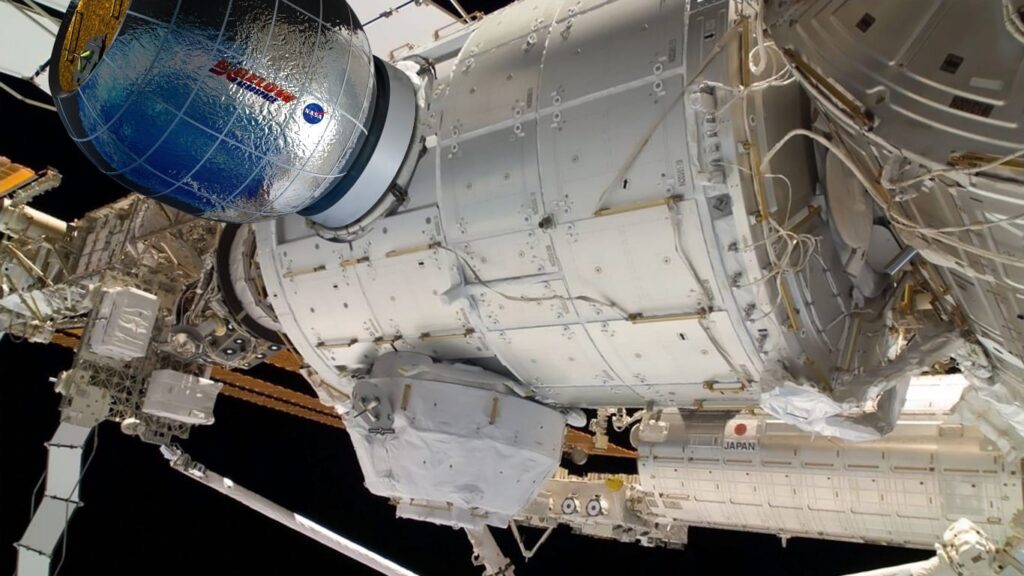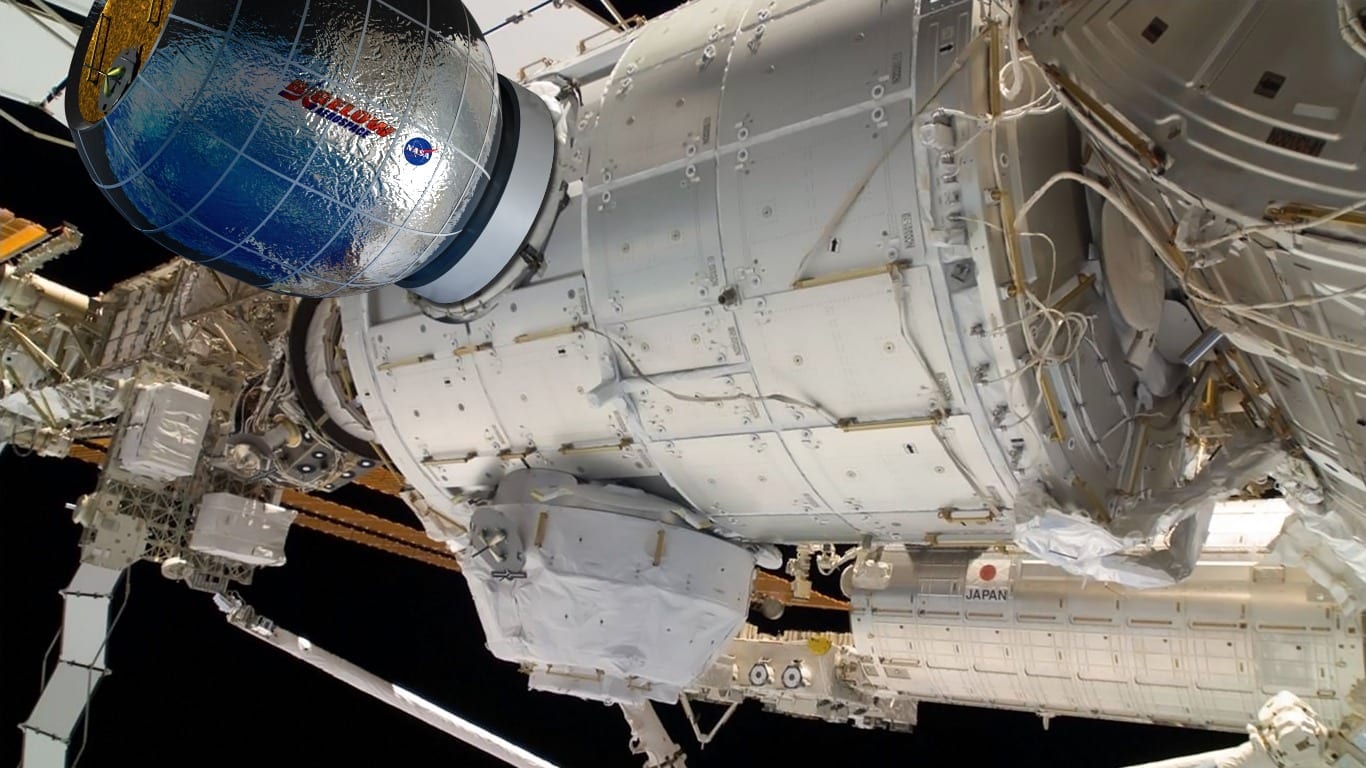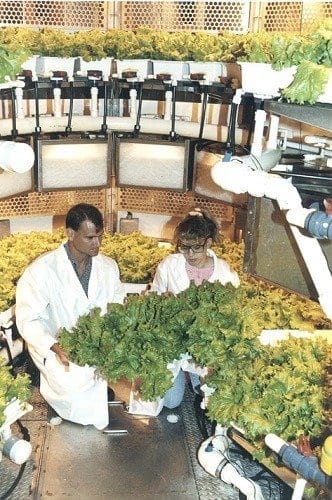
Space travel: Pump it up, Scotty
AT 73 metres long and 420 tonnes, the International Space Station is the biggest artificial object in space. And it is growing: its 15 existing modules are due to be joined by five more before the decade is out. On April 8th, if all goes according to plan, a rocket will lift off from Cape Canaveral in Florida carrying the first of these new additions. But it is no ordinary module.
The Bigelow Expandable Activity Module (BEAM—illustrated above) is the first bit of the ISS created entirely at the initiative of a private company. Bigelow Aerospace, its manufacturer, is an American space firm set up in 1999 by Robert Bigelow, a businessman who made his money in the hotel trade. And unlike the rest of the ISS, which is essentially a series of space-going aluminium cans, the BEAM is made from cloth. It is folded up and stowed for the journey into orbit, much like a tent, and then inflated to its full size after being attached to the station.
An inflatable space station might sound a bit mad (perhaps for that reason, Bigelow Aerospace prefers the word “expandable”). But many space cadets are fans of the idea. In the 1950s Wernher von Braun, a Nazi rocket prodigy poached by the Americans after the second world war, described a space station 75 metres across with room for 80 people, made of reinforced, inflatable rubber tubes. In the 1960s, with the space race in full swing, NASA built a full-sized test model of a smaller, 7.3 metre model. And in the 1990s the agency returned to the idea with a design called the TransHab, an inflatable spaceship designed to take a crew of humans all the way to Mars. But that mission never happened. In 1999, in a neat bit of symmetry, Bigelow Aerospace bought the relevant patents from NASA and began working on the technology itself.
Inflatable spaceships offer several advantages, but the main one is mass. An inflatable module is much lighter than its metal counterpart, and mass is the rocket scientist’s worst enemy. Lugging mass into orbit requires a lot of energy. Adding extra mass requires more fuel. That fuel, in turn, has mass of its own, requiring yet more fuel to lift, meaning that even a small increase in mass can end up requiring a dramatically bigger rocket. Bigelow Aerospace reckons that its inflatable designs offer more than twice as much internal volume per kilo as a traditional, metal design.
Space is another advantage. The size of a rigid spacecraft is limited by the size of the rocket that launches it.
Learn more: Space travel: Pump it up, Scotty
The Latest on: Inflatable spaceships
[google_news title=”” keyword=”Inflatable spaceships” num_posts=”10″ blurb_length=”0″ show_thumb=”left”]
via Google News
The Latest on: Inflatable spaceships
- Leeds may hate the play-offs, but they must find a way to bounce back for themon May 5, 2024 at 12:38 am
With automatic promotion now gone, Daniel Farke's side must dust themselves down and prepare to face his former club Norwich City ...
- The World's Largest Bounce House Will Be in Sauget Next Weekendon May 3, 2024 at 6:58 am
If you associate Sauget solely with strip clubs and heavy industry, prepare to be shook: Next weekend, the East Side town originally christened Monsanto, Illinois, is going to be crawling with kids.
- Inflatable, 20-foot rainbow arcs are coming to downtown Milwaukee this summeron May 1, 2024 at 9:32 am
Remember the giant, inflatable bubbles outside downtown ... light display is accompanied by a unique soundscape, making the space a fully immersive experience." The arcs were created by the ...
- Inflatable, 20-foot rainbow arcs are coming to downtown Milwaukee this summeron May 1, 2024 at 8:32 am
The "Elysian Arcs" were designed by Atelier Sisu, the same Australian studio behind last summer's giant, inflatable bubbles public art installation.
- Best inflatable kayakson April 30, 2024 at 5:00 pm
The worst inflatable kayaks don't have enough space for occupants, are a nightmare to handle on the water and even worse to pack up and transport. But the best are fantastic fun on the water, are ...
- Are bounce houses safe for kids? What to know after Arizona toddler dies in tragic incidenton April 30, 2024 at 11:40 am
An Arizona toddler was killed in a tragic bounce house incident. Here's how to keep your children safe when playing in and setting up bounce houses.
- iKamper Skycamp expandable rooftop tent goes inflatable glampingon April 28, 2024 at 11:30 am
The original Skycamp from iKamper was a true innovator in a now-overcrowded rooftop tent (RTT) market. IKamper has built out the Skycamp brand over the years, adding smaller, lighter models and ...
- Newark: Explorers invited to walk inside inflatable whaleon April 26, 2024 at 11:54 pm
The inflatable sculpture has been brought to Newark on Saturday as one of a series of events to drive interest in the town centre. Explorers would be able to walk inside it, with other activities ...
- The Best Inflatable Pool Deals on Amazon to Help You Beat the Heat This Summeron April 25, 2024 at 9:55 am
Once temperatures start to rise, the best inflatable pools become affordable alternatives to an in-ground pool that can help you beat the heat. For those with limited space and perhaps an even more ...
- Revolutionizing Space: Inflatable Habitats Redefine Explorationon April 22, 2024 at 11:40 pm
In the field of space exploration, inflatable space habitats have captured imaginations as a novel concept. Although conceived as far back as the 1960s during the peak of the original space race, it ...
via Bing News











